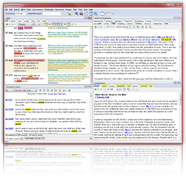Montfort, Simon De
Montfort, Simon De a bold, merciless, and superstitidus, but devoted follower of the papacy, was descended from the counts of Montfort, near Paris. He was born about the middle of the 12th century. His career dates from the year 1199, when he appears as a leader in the Crusade of Cery, where he was associated with Rainald de Montmirail, Garnier, bishop of Troyes. Walther of Brienne, and the marshal of Champagne, Geoffroy of Villehardouin, and others. The crusade set forth October 8, 1202. A bargain had been previously made with the Venetians, by which the latter agreed to furnish "ships and other conveniences to pass the sea." When the time for embarkation arrived, the Crusaders were lacking 34,000 marks of the stipulated price. The "wise old doge" saw his advantage, and proposed that Venice would fulfil her part of the treaty if, in discharge of the 34,000 marks of silver, the Crusaders would lend their aid in the conquest of Zara. After much hesitation, the plan was acceded to by all but De Montfort. "We are Christians; we war not against our brother Christians," said he. " His object in assuming this position," says Villehardouin, "was to break up the misguided army." After the capture of Zara, the Crusaders advanced to Constantinople for the purpose of placing young Alexius on the throne. The pope denounced the design. He excommunicated the Venetians; but of this no one took the slightest heed, except De Montfort. He, with his brother and a few French knights, separated themselves from the camp of the Crusaders, passed over to the king of Hungary, and, amid many difficulties, made for the Holy Land to fulfil his vows to the Church. He finally, however, returned home, and after a short rest took up arms again at the summons of pope Innocent III, and in the summer of 1209 he was made leader of the crusade against the Albigenses. Under his guidance and that of the pope's legate, Amaury, abbot of Citeaux, the crusading army marched into Languedoc and besieged the town of Bdziers, which was stormed July 22, 1209. A horrible massacre ensued. One of the superior officers inquired of the abbot of Citeaux how they were to distinguish the heretics from the faithful: "Slay them all!" returned the savage Churchman, "for the Lord knoweth those that are his." Not a living soul was spared. It is said that fifteen thousand people were thus mercilessly slaughtered in this one place. Carcassone was scarcely better treated; and at Lavaur the ferocious deeds of Montfort made his name a byword of tyranny and cruelty. In 1210 De Montfort was invested by Peter of Aragon with the viscounty of Beziers and Carcassone. Peter designed, no doubt, in this way to conciliate De Montfort, and protect his (Peter's) kinsmen from the rapacity and savagery of De Montfort. He was, however, disappointed, and in 1213 Peter crossed the Pyrenees with a force superior to that of Simon to protect his own. Yet Simon, impressed with a fanatical conviction that God would give him the victory, confessed his sins, made his will, placed his sword upon the altar, and declared that he took it back from God to fight his battles, and at the battle of Muret defeated and slew Peter and the larger part of his army. After the battle of Muret, the progress and success of the Crusaders were uninterrupted. Toulouse was taken in 1215. De Montfort was chosen prince of the whole subjugated territory; a strict inquisition after heretics was ordered, and the Church of Rome, pleased with the faithfulness of her servant Simon, at a Council of the Lateran, November, 1215 (styled the twelfth General Council), confirmed him in all his conquests. On his return to Northern France, he was received with the greatest honor as the champion of the faith, and hailed with acclamations: "Blessed is he that cometh in the name of the Lord!" The remaining years of the life of De Montfort were consumed in a bloody struggle to maintain his ascendency over the territory he had subdued. During the year 1216 the people, under the leadership of the younger count Raymond, broke out in general insurrection. But success still followed De Montfort. He with his army sacked Toulouse, and plundered the inhabitants to the very last piece of cloth or measure of meal. "Oh, noble city of Toulouse!" exclaims the troubadour, "thy very bones are broken!" The ensuing year the war with the young count Raymond continued to the advantage of De Montfort, till suddenly the old count Raymond appeared before Toulouse. The city received him with the utmost joy. New walls were built and new fortifications raised. It was in the siege of this place that De Montfort lost his life, June 25, 1218; when heading an attack, a stone from an engine struck on the head the champion of Jesus Christ (as he was called by his admirers), and he died on the spot. His fanatical followers reproached God with his death. A monkish historian adds also that he received five wounds from arrows; and in this respect likens him to the Redeemer, "in whose cause he died, and with whom we trust he is in bliss and glory." A daring and skilful leader; chivalric, affable, and popular; enthusiastically devout and fanatically attached to Romanism; ambitious, unscrupulous, and remorseless, he naturally rose to the position of guiding spirit in the turbulent times in which he lived and the cruel war in which he engaged. See Milman, Hist. of Latin Christianity; Chronique de Simon, Comte de Montfort (printed in Guizot's Memoires relatifs a l'Histoire de France); Hoefer, Nouv. Biog. Generale, 36:246-257; and the histories of the Albigenses (q.v.).

